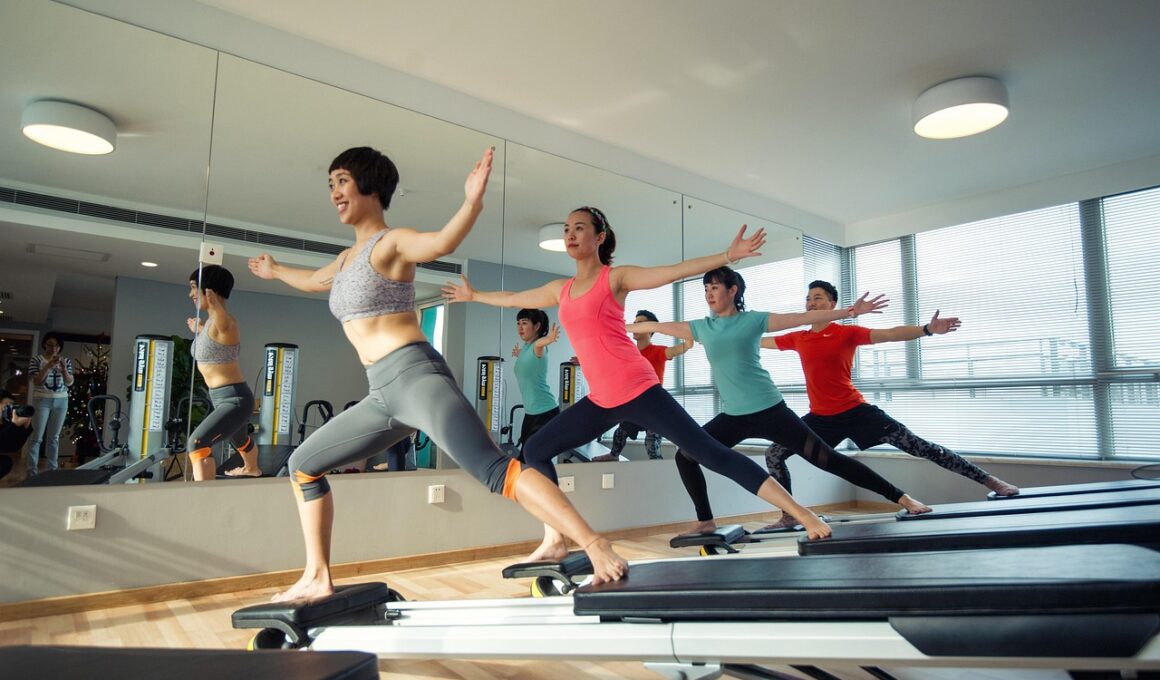Essential Pilates Safety Guidelines for All Levels
Pilates is a fantastic way to enhance flexibility, strength, and overall body awareness. However, like any form of exercise, it is crucial to prioritize safety during workouts. Understand your body limits to avoid injuries. Begin by consulting a healthcare professional if you have pre-existing conditions or concerns. Focus on proper form and alignment. This not only maximizes benefits but also minimizes injury risk. Equally important is breathing. Proper breathing techniques enhance your movements and provide stability. Listen to your body, and if something feels wrong, stop immediately. A certified instructor can provide valuable feedback and adjustments during practice. Be cautious when trying new challenges; progress gradually. Use quality equipment, such as mats and props, to ensure safety. Always warm-up before starting your Pilates routine and cool down afterward. This enhances flexibility and prevents injuries. Lastly, stay hydrated! Drink water before, during, and after your workout. Following these guidelines will ensure that you enjoy the extensive benefits of Pilates while keeping your body safe and healthy. Remember, safety is the foundation of effective Pilates practice.
Another essential aspect of Pilates is choosing the right environment. Make sure you practice in a clean, spacious, and well-ventilated area. Ensure the flooring is suitable for Pilates activities. Avoid overly soft surfaces like carpet that can lead to instability. Create a dedicated space for your practice that is free from distractions. Having an area where you feel comfortable will enhance your concentration and performance. Regularly assess your Pilates setup. Your equipment should be in good condition; check for any wear and tear. A mat that isn’t appropriately cushioned can lead to discomfort and potential injuries. Practicing safe transitions is essential. When moving between exercises, focus on control. This is when most injuries occur. If you’re attending a class, ensure your instructor is certified and has the necessary experience. This knowledge significantly reduces accident risks. Make sure to inform your instructor about any limitations you may have. This allows them to adjust exercises accordingly, keeping you safe. Prioritize safety at every stage of your practice, and you will reap the long-term benefits of Pilates.
Importance of Mindfulness in Pilates
Mindfulness plays a significant role in the overall effectiveness of Pilates. Being present in the moment allows you to connect with your body, understanding its needs and limits. It’s crucial to be aware of your movements and breath throughout your practice. This awareness helps to align your intentions with your physicality, improving both performance and safety. Practicing mindfulness also reduces stress and promotes relaxation, which is vital for safe workouts. As you engage in each exercise, focus on how your body feels—notice any tension, discomfort, or strain. Modify your movements if necessary. Never push through pain, as this can lead to injury. Mindfulness encourages you to take breaks when needed, ensuring your body has enough time to recuperate. Ensuring muscle engagement without excessive strain is key for maintaining safety. Incorporate breathing exercises into your routine; they help to ground you in the present. Create a mental checklist before each session. Ask yourself about how you can be unharmful to your body while still achieving your fitness goals. Above all, remember that success in Pilates comes from a harmonious balance between effort and safety.
When beginning Pilates, it’s essential to start slowly, especially if you’re new to physical exercise. Enlist an instructor for guidance on foundational moves. They can offer modifications based on your fitness level, ensuring your practice aligns with your individual capabilities. Start with beginner classes, focusing on mastering basic techniques first. Gradually increase the complexity of your workouts only when you feel ready. Aim to practice regularly, allowing your body to adapt progressively. This measured approach not only enhances safety but also builds your confidence in each movement. Consider documenting your progress—this can pave the way for motivation while helping you remain aware of your limits. Align your goals realistically; understand that Pilates is a journey that requires patience and consistency. Remember to rest days are an essential part of any workout regimen. Utilize these days for recovery, and embrace active recovery practices like gentle stretching or walking. Lastly, engage community by joining classes or forums. Connecting with other Pilates enthusiasts can provide added motivation and support, which boosts your practice in a safe and enjoyable manner.
Listening to Your Body
Listening to your body is an integral principle in Pilates practice. Each individual’s body responds differently; therefore, it’s essential to pay attention to how you feel during workouts. Pain is your body’s way of signaling distress. If you experience discomfort, don’t hesitate to modify or skip the exercise altogether. Your primary responsibility is to create a safe practice space that honors your limits. Consider working with a physical therapist, especially if you are recovering from an injury, to receive tailored advice. Keep in mind that Pilates isn’t about perfection; it’s about working within your existing capabilities. Focus on quality rather than quantity. Even simple movements can yield significant benefits if performed correctly. Incorporate balance and control within your workout—never rush through exercises. Take your time to master each movement at your own pace. Be open to adjusting your routine if certain areas feel tight or sore. Finally, maintaining a positive mindset can transform your experience, making it more enjoyable and less frustrating. Celebrate small achievements in your practice—each step forward builds confidence and encourages safe engagement.
Using appropriate modifications is crucial for maintaining safety, especially in Pilates. Many exercises have variations to suit beginners as well as advanced practitioners. If a move feels too challenging or risky, always opt for a modification. Familiarize yourself with common alterations that maintain effectiveness without compromising safety. For instance, if performing a roll-up is difficult, try bending your knees instead. Each time you modify an exercise, you ensure your body stays safe while still participating. Apart from physical adjustments, utilize props such as resistance bands or towels to enhance stability. These tools can offer additional support, making exercises easier to perform while ensuring proper form. Pilates should never leave you feeling exhausted; the aim is to challenge your muscles gently and progressively. If fatigue sets in, it’s a clear sign you need to scale back. Regularly incorporate rest intervals into your practice. During these breaks, hydrate and refocus, allowing your body to recover before continuing. Engaging in safe modifications and using props can help you maintain a consistent and enjoyable Pilates experience while safeguarding your health.
Conclusion: Embrace Safety for Pilates Success
In conclusion, embracing safety within your Pilates practice is crucial for success in the long run. By implementing the guidelines discussed, you create an environment where you can thrive in your physical activities without injuries. Prioritize knowledge about your body and seek professional guidance as necessary. Establishing a consistent Pilates regime will also promote muscle memory while enhancing alignment and strength. Don’t rush your progress—take your time to develop a strong foundation in your practice. Mindfulness will further enhance your journey, allowing greater body awareness and control. Create a supportive environment where safety takes precedence, ensuring you stay motivated as you advance. If you encounter challenges, remember that modifications and props are your allies on this journey. Remain committed to your goals while navigating your limits with kindness and patience. Keep reassessing and adjusting as your practice evolves, maintaining focus on safe practices above all else. Lastly, nurture the passion for Pilates by connecting with others, sharing experiences, and learning together. Ultimately, a safe practice leads to enjoyment, well-being, and sustained physical growth in your Pilates journey!
This is another paragraph with exactly 190 words…


